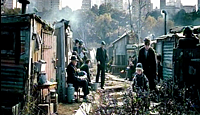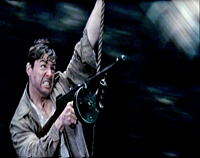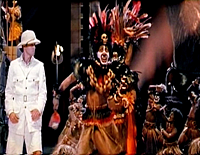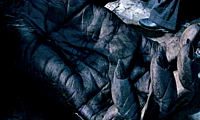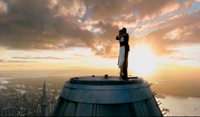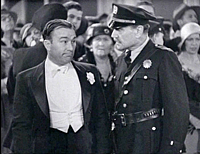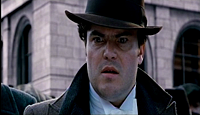The Passion of the Kong
How to Turn a Classic into a Masterpiece
An Appreciation by Barry M. Lamont
Secular Poison, Spiritual Redemption
Peter Jackson does not care much for human civilization. This is made clear from the very beginning: after a wink at the audience, the film opens on zoo animals, the most impressive ones confined in cages which are much too small. We get to see the real 1933, a time of bread lines, shantytowns, protests, and forcible evictions. The people in charge are mean-spirited, crude, uncaring; kindness is ground out of the world.
When the expedition arrives at Skull Island, they leave civilization and its discontents behind. A well-chosen quote from Heart of Darkness, ostensibly a foreshadowing of Kong, actually describes everyone who enters Kong's world. The people who abandon the artifice of civilization - those who survive - are all transformed for the better: Ann opens up to Kong emotionally, in a way she had not opened up to Jack; Jack, a man of words, finally learns to take action; Jimmy, the shady cabin-boy, learns about responsibility; Captain Englehorn, who swore he would leave the shore party behind, mounts a rescue mission - twice; and even Bruce Baxter becomes the heroic character he plays in the movies, if only for a moment. Denham is the only one who can't, or won't, open his eyes; when he smashes a bottle of chloroform in Kong's face, we recoil at the ugliness of his action.
Back in New York, the poison of civilization again works its magic. Ann and Jack, surrounded by multitudes, are alone; she is a pretty face in the background, he is back to writing words he should have spoken. Denham, back in his element, is delighted to associate with the same studio executives he despised earlier; he takes pride in his latest self-promoting, crowd-pleasing vulgarity, a patronizing "primitive people" spectacular complete with Hollywood's idea of a native ritual, kitschy and drained of meaning - an impression only reinforced when Bruce Baxter starts doing the Charleston with one of the "natives", a small but telling addition by Peter Jackson. (Interestingly, Jackson lifts the music, the costumes, and most of the choreography of the ritual directly from the original 1933 Skull Island sequence; this is one of many touches he describes as a "homage", although here one does get the feeling that he is also saying, "See how silly this looks? Mine was better, truer, scarier.")
Kong's death does not redeem civilization; Jackson makes this abundantly clear. The camera passes over Kong's lifeless hand, outstretched in a gesture we have seen before, now empty forever, but the image goes by quickly and at an odd angle, so the effect is subliminal rather than clumsy and manipulative. We see the soldiers laughing and posing for photos in front of Kong's body; we see the photographers climbing up onto his abdomen, like vermin, for a better shot; we see the police doing their "That's it, folks, show's over, step back" routine, as if this were nothing more momentous than an overturned fruit cart. Bystanders wonder, uncomprehendingly, how Kong could have made the tactical mistake of climbing to the top of the Empire State Building. Nothing has changed; nothing has been learned.
But three people have been redeemed. Where the 1933 film offers a simple denouement after Kong's death, Peter Jackson places the emotional climax of two other story arcs in the few minutes before the film ends, a triple-punch which the 1933 version can not match.
Two of the people, of course, are Ann and Jack. As Ann looks down at Kong from the Empire State Building, unsure whether she should just follow him down, Jack appears; they look into each other's eyes, then finally embrace. It was the journey to Kong's home which first brought them together; it was their interaction with Kong which encouraged them to love; it was his capture, and Jack's failure to understand how wrong it was, which drove them apart; and it is his death which makes them understand how much they need each other. This is the moment their whole story has been building towards, an affirmation to balance the tragedy. The 1933 film gives Ann and Jack no comparable character arc, no real chance to grow; its climax is simply an action sequence - albeit an iconic and groundbreaking one - and while we may be sympathetic to Kong's plight, it does not rise to the level of tragedy.
The third person redeemed by Kong's death is the most surprising, because he is the one person who was never touched by Kong's life: Carl Denham. He says the film's final line in both 1933 and 2005, and it is a final measure of Peter Jackson's skill that while the words are identical in both versions, the emotional impact could not be more different.
The line, of course, is "It wasn't the airplanes; it was Beauty killed the Beast." In 1933, Denham's primary regret seems to be that the adventure has ended, and that his show has lost its star attraction. The reference to the fairy tale (and the Arabian proverb) is literal, simplistic: Ann is Beauty, Kong is the Beast, the story line Denham was pushing all through the film. There is no sense of transformation.
In 2005, the line is spoken with a hushed sense of awe and wonder. (Hushed awe and wonder are not normally part of Jack Black's repertoire, but he makes it work.) The fairy tale is used creatively, as a metaphor; Denham finally understands what he has destroyed: an extraordinary being, a creature capable of understanding beauty in ways that Denham himself can't reach. For the very first time, in the final moments of the film, Denham seems capable of genuine humanity; like that other Story, Peter Jackson's King Kong ends on a note of profound tragedy, but also one of hope.
[Matthew 27:54 : Now when the centurion, and they that were with him, watching Jesus, saw the earthquake, and those things that [occurred], they feared greatly, saying, Truly this was the Son of God.]
When the expedition arrives at Skull Island, they leave civilization and its discontents behind. A well-chosen quote from Heart of Darkness, ostensibly a foreshadowing of Kong, actually describes everyone who enters Kong's world. The people who abandon the artifice of civilization - those who survive - are all transformed for the better: Ann opens up to Kong emotionally, in a way she had not opened up to Jack; Jack, a man of words, finally learns to take action; Jimmy, the shady cabin-boy, learns about responsibility; Captain Englehorn, who swore he would leave the shore party behind, mounts a rescue mission - twice; and even Bruce Baxter becomes the heroic character he plays in the movies, if only for a moment. Denham is the only one who can't, or won't, open his eyes; when he smashes a bottle of chloroform in Kong's face, we recoil at the ugliness of his action.
Back in New York, the poison of civilization again works its magic. Ann and Jack, surrounded by multitudes, are alone; she is a pretty face in the background, he is back to writing words he should have spoken. Denham, back in his element, is delighted to associate with the same studio executives he despised earlier; he takes pride in his latest self-promoting, crowd-pleasing vulgarity, a patronizing "primitive people" spectacular complete with Hollywood's idea of a native ritual, kitschy and drained of meaning - an impression only reinforced when Bruce Baxter starts doing the Charleston with one of the "natives", a small but telling addition by Peter Jackson. (Interestingly, Jackson lifts the music, the costumes, and most of the choreography of the ritual directly from the original 1933 Skull Island sequence; this is one of many touches he describes as a "homage", although here one does get the feeling that he is also saying, "See how silly this looks? Mine was better, truer, scarier.")
Kong's death does not redeem civilization; Jackson makes this abundantly clear. The camera passes over Kong's lifeless hand, outstretched in a gesture we have seen before, now empty forever, but the image goes by quickly and at an odd angle, so the effect is subliminal rather than clumsy and manipulative. We see the soldiers laughing and posing for photos in front of Kong's body; we see the photographers climbing up onto his abdomen, like vermin, for a better shot; we see the police doing their "That's it, folks, show's over, step back" routine, as if this were nothing more momentous than an overturned fruit cart. Bystanders wonder, uncomprehendingly, how Kong could have made the tactical mistake of climbing to the top of the Empire State Building. Nothing has changed; nothing has been learned.
But three people have been redeemed. Where the 1933 film offers a simple denouement after Kong's death, Peter Jackson places the emotional climax of two other story arcs in the few minutes before the film ends, a triple-punch which the 1933 version can not match.
Two of the people, of course, are Ann and Jack. As Ann looks down at Kong from the Empire State Building, unsure whether she should just follow him down, Jack appears; they look into each other's eyes, then finally embrace. It was the journey to Kong's home which first brought them together; it was their interaction with Kong which encouraged them to love; it was his capture, and Jack's failure to understand how wrong it was, which drove them apart; and it is his death which makes them understand how much they need each other. This is the moment their whole story has been building towards, an affirmation to balance the tragedy. The 1933 film gives Ann and Jack no comparable character arc, no real chance to grow; its climax is simply an action sequence - albeit an iconic and groundbreaking one - and while we may be sympathetic to Kong's plight, it does not rise to the level of tragedy.
The third person redeemed by Kong's death is the most surprising, because he is the one person who was never touched by Kong's life: Carl Denham. He says the film's final line in both 1933 and 2005, and it is a final measure of Peter Jackson's skill that while the words are identical in both versions, the emotional impact could not be more different.
The line, of course, is "It wasn't the airplanes; it was Beauty killed the Beast." In 1933, Denham's primary regret seems to be that the adventure has ended, and that his show has lost its star attraction. The reference to the fairy tale (and the Arabian proverb) is literal, simplistic: Ann is Beauty, Kong is the Beast, the story line Denham was pushing all through the film. There is no sense of transformation.
In 2005, the line is spoken with a hushed sense of awe and wonder. (Hushed awe and wonder are not normally part of Jack Black's repertoire, but he makes it work.) The fairy tale is used creatively, as a metaphor; Denham finally understands what he has destroyed: an extraordinary being, a creature capable of understanding beauty in ways that Denham himself can't reach. For the very first time, in the final moments of the film, Denham seems capable of genuine humanity; like that other Story, Peter Jackson's King Kong ends on a note of profound tragedy, but also one of hope.
[Matthew 27:54 : Now when the centurion, and they that were with him, watching Jesus, saw the earthquake, and those things that [occurred], they feared greatly, saying, Truly this was the Son of God.]
